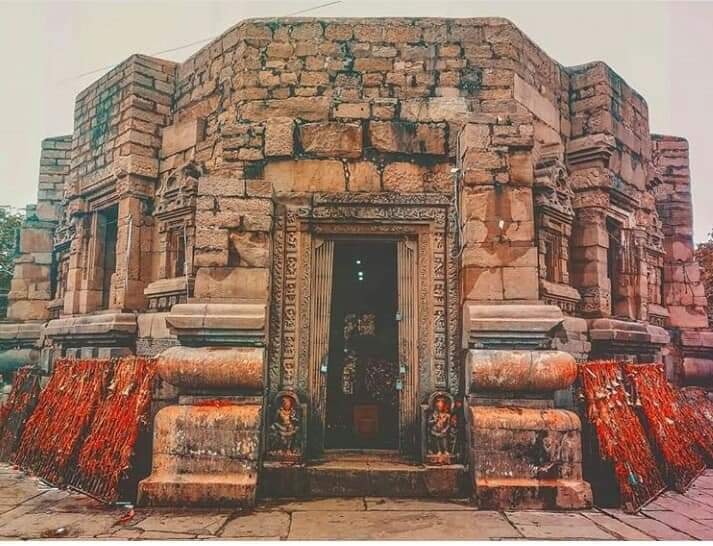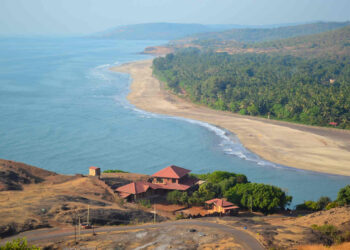Maa Mundeshwari Temple, located in Kaimur district, Bihar, atop the 608-feet-high Mundeshwari Hills near the Son River, is a revered site where devotees worship Lord Shiva and Goddess Shakti. Known simply as Mundeshwari Temple, it is one of the oldest functioning Hindu temples in the world. The temple is dedicated to Maa Mundeshwari, a form of Durga, and features a unique four-faced Shiva linga. Regarded as a Shakti Pitha, it is famed for its traditional bloodless goat sacrifices and the linga that reportedly changes color three times a day.
History of Mundeshwari Temple, Bihar
Mundeshwari Temple is believed to have been established around 108 CE, according to a plaque by the Archaeological Survey of India (ASI), making it one of the oldest functioning Hindu temples in the world. Some scholars suggest its origins go back even further, to 3–4 BCE, when Lord Vishnu may have been the main deity, though his idol disappeared over time. By 348 CE, a form of Shiva, Viniteswara, was worshiped alongside, and by the 7th century, as Shaivism grew, the local Chero tribe elevated Maa Mundeshwari, a form of Shakti, as the primary deity.
A 389 CE inscription and a Brahmi seal from Sri Lankan King Dutthagamani (101–77 BCE) indicate that hindu pilgrims traveled from distant regions visit the temple at the time. British travelers such as R.N. Martin and Francis Buchanan documented the temple’s fame between 1812 and 1904. In 1892 and 1903, a broken inscription linked to King Udayasena, possibly from 108 CE or around 570–590 CE, was discovered.
The ASI has protected Mundeshwari Temple since 1915, and recent restorations cleaned soot and preserved ancient carvings. The temple sits atop a solitary hill, accessible via stone steps. After India’s independence in 1947, a local trust assumed responsibility for its upkeep. Today, visitors often capture Mundeshwari Temple photos to admire its enduring ancient architecture and spiritual ambiance.
Legends of Mundeshwari Temple, Bihar
One famous tale says Maa Mundeshwari, a form of Durga, killed the demon Munda here, as described in the Durga Saptashati. The temple’s name may come from this demon, or from “Mandaleshwari,” meaning the goddess of the hill. Another version calls her Varahi, riding a buffalo rather than killing it, and some legends say she appeared from Munda’s head after his death.
The four-faced Shiva linga, known as Chaturmukhi, is believed to possess unique powers, changing color, black, red, yellow, depending on sunlight. Locals also say the temple ground is so sacred that visitors cannot stare at Maa Mundeshwari’s idol for long without feeling dizzy.
A remarkable tradition here is the bloodless goat sacrifice: priests chant mantras, the goat faints, and rice grains revive it unharmed. Mundeshwari Temple photos often capture the idol with her ten arms and the buffalo, drawing many pilgrims and visitors alike.
Architecture of Mundeshwari Temple, Bihar
Mundeshwari Temple, Bihar, is made of stone in an unusual octagonal shape, said to be the earliest Nagara-style temple in the region. Inside, a four-faced Shiva linga sits at the center, and Maa Mundeshwari’s ten-armed idol, riding a buffalo as Mahishasuramardini, is in a niche on the east wall. The original shikhara is missing, replaced by a flat roof.
Four of the eight sides have doors or windows for entry and exit, while the other walls have niches for small statues. Door jambs show carvings of Dvarapalas, Ganga, Yamuna, and other gods. Old sculptures of Ganesh, Surya, Vishnu, Kartikeya, and Parvati lie around, some now in the Indian Museum, Kolkata. A Nandi statue faces west. The Chaturmukhi linga changes color with sunlight, and the eight sides are linked to the eight Ashtamatrika goddesses. A Navarana Yantra pillar stands near the steps. The ASI has maintained the temple, keeping its ancient look intact.
Rituals and Festivals
The temple gets lively for festivals. Navratri, in April and October, is huge, with a big mela drawing 10,000–20,000 folks. Devotees offer prayers, fast, and dance, and some see sunlight hit Maa Mundeshwari’s idol, a wonder caught in Mundeshwari Temple photos. Shivratri, in February or March, honors Shiva with all-night prayers, milk on the linga, and mantras. About 12–14 lakh pilgrims visit yearly, soaking in the holy moments.
Daily, priests do aarti at 11:30 AM and before sunset, with flowers, incense, and ghee lamps. The bloodless goat sacrifice, unique here, stuns folks: the animal faints, then wakes unharmed. VIP darshan costs ₹501, and Rudrabhishekam needs trust permission. Inside Mundeshwari Temple, no photos are allowed but Mundeshwari Temple images from outside show the octagonal build and hilltop calm.
Information for Travelers
Hours and Entry: The Maa Mundeshwari Temple is open every day from 6:00 AM to 7:00 PM. Entry is free, though VIP darshan costs ₹501. Photography and video recording inside the sanctum are not allowed. Visitors must wear modest clothing, such as dhotis or sarees, and remove shoes before entering. The temple briefly closes from 12:00 PM to 12:20 PM.
How to Get There:
Air: No airport in Kaimur; Varanasi Airport is 102 km off, with flights to Delhi (1.5 hours) and Kolkata (1 hour). Taxis take 3 hours to the temple.
Train: Bhabua Road Station, 22–29 km off, connects to Patna (2 hours) and Varanasi (1 hour). Autos take 50 minutes to the temple.
Road: Kaimur is 200 km from Patna, 100 km from Varanasi, via NH-30 through Arrah. Buses or taxis from Bhabua (10 km) reach the temple in 1 hour.
Best Time to Visit: October to March is cool, 10–25°C. Early mornings are quiet. Navratri and Shivratri are busy, with 10,000–20,000 devotees, so come early. Summers hit 45°C, so avoid April to June.
Nearby Attractions:
Durgawati River Dam: 10 km off, a calm spot for views.
Kaimur Wildlife Sanctuary: 20 km off, with leopards and birds.
Telhar Waterfall: 30 km off, a scenic nature spot.
Chandrawati Temple: 15 km off, another old shrine.











